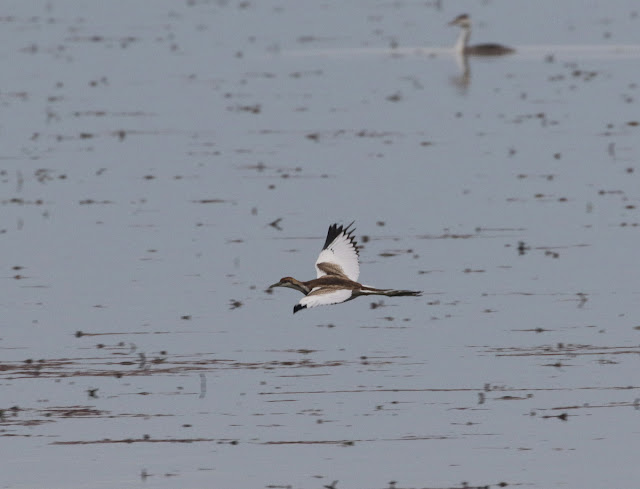The winds eased on Thursday 31st allowing sailing the following day... and more time for birds to leave. The problem with a day trip to the island from November onwards is that you only get 3.5 hours of birding because of the ferry's earlier winter return timetable. In effect only a little over three hours birding which makes the 404km each way drive seem much further than when I'm staying on the island.
I used to think there must be a good reason why the ferry schedule changes in winter. Now I'm not so sure. Why does it need to leave the island an hour earlier and be back in Wajima at 15:30 back in Wajima 1.5 hours before sunset at this time of year? It's not as if they have a lot to do once back in port and they surely don't require daylight to do it... Wajima is on the grid. Perhaps they don't realise the port has lighting because they've never been there after dark. Strange as it may seem now, when I first went to Hegurajima we drove all round Wajima looking for a convenience store... there were none! For many subsequent visits I had to be prepared and provisioned before getting out into the sticks then there was one, and the following year they were all over the town. A bit like Daurian Redstarts in mid-October. And another thing while I'm at it... did you ever wonder why the ferry leaves Hegura five minutes before the 15:00 (now 14:00) scheduled departure time? It seems departure time is as the ferry leaves the harbour not the quay. Thank goodness other forms of public transport don't follow the same logic, even other ferry services I use for that matter.
What about the birds then? I'm coming to that.
There were enough birds on the island to encourage the thought that a mega was just around the corner. Perhaps there was. Unfortunately you can't turn all the corners in three hours and I obviously didn't choose the right one(s).
Highlights were Eurasian Skylarks, ie not japonica, and a couple of Pine Buntings. Neither are unexpected here but equally they aren't birds I'm going to see staying at home in Kyoto. Red-throated Pipit I might see once in a blue moon in Kyoto while Stejneger's Stonechat, White's Thrush and Eyebrowed Thrush are birds I could see but usually don't. I'd sum it up as a low number of species with a high degree of scarcity from the Kyoto birders perspective.
It's actually worth going for the Pine Buntings alone! I didn't see them until five minutes before boarding the ferry, they were just hopping around on the road in the harbour.
 |
| Great birds, great family. |
 |
 |
 |
 |
 |
| I definitely could have seen Rustic Bunting staying in Kyoto. But not on a rugged rocky headland with red berries! |
In the harbour area a couple of people were trying to get good views and photographs of O Hibari (large skylark). Maybe I'm totally wrong on this but I often feel the name O Hibari is used as a catch-all for the various races of Eurasian Skylark that could turn up here in autumn/winter due to the difficulty/impossibility of confirming racial identity; I am told by a friend that O Hibari refers specifically to pekinensis and that lonnbergi is Karafuto Chu Hibari but it's always the former name I seem to hear mentioned. Incidentally, I'm told Chu Hibari intermedia hasn't been recorded in Japan which, again, is presumably is down to the difficulty/impossibility of separating the races of Eurasian Skylark in the field rather than it never reaching these shores.

Female Stejneger's Stonechat, probably a first autumn with the heavy white tips to the primary coverts.
 |
As there wasn't a great deal of interest sufficiently close to photograph on the island, good images of the skylarks would have been very welcome, I'll add some shots of a first autumn Asian Brown Flycatcher taken on Oct 12th during the previous visit. This was quite a strikingly marked bird which I first saw in heavy rain making observation and more particularly photography difficult. I was struck by flashing white about the wings as I first glimpsed it dash away between the trunks of some pines ahead. Ever the optimist, I was excited by the possibility of Pied Flycatcher and in true ficedula-style it vanished. Fortunately I did relocate it some time and though that brought spirits down on a par with the weather it was a relief to sort it out. I found it again the following day in much better weather conditions about 400m from the original site and was able to get a few closer shots. I assume the the discrepancy between this and the Asian Brown Flycatchers I expect to see at this time of year are all due to retained juvenile body feathers. According to Leader (British Birds 2010), juvenile Asian Brown Flycatcher undergoes a complete body moult before migration and only the exceptional bird will retain any juvenile feathers beyond August. Certainly I've found very few online images of Asian Brown showing any of the features of this bird and none with all of them.
 |
| The white markings on the forehead and crown are formed by white tips to some feathers. |
 |
 |
| This Japanese Bush Warbler shot is also from mid-October when they were very common on the island. I'm uncertain whether they are far less common now or simply less vocal. |



















